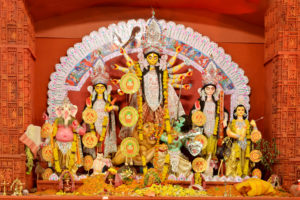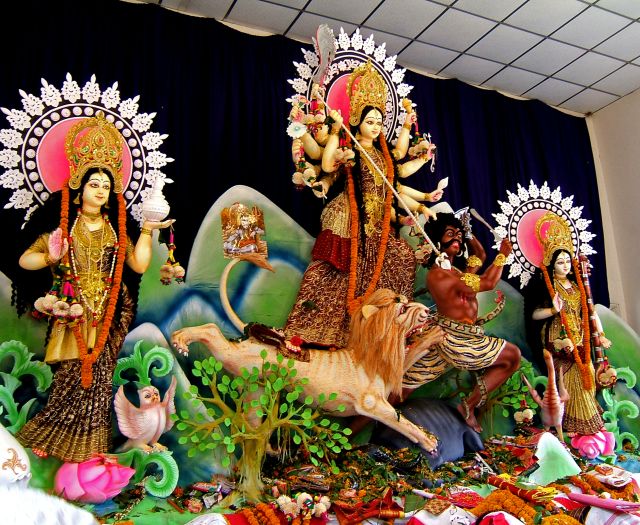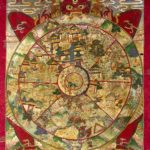The festival of Durga Puja is a ten-day festival held during the Hindu month of Ashwin (September-October) each year. The Goddess Durga and her four children Ganesh, Karthik, Laxmi, and Sarawati – are worshipped with elaborate rituals and traditions typical to the region of celebration. Today, however, it is celebrated with pomp and ceremony across the world, wherever the Bengali community of Hindus reside, for it is the prime festival of Bengali Hindus.
This is the festival, where the preparations commence with the making of images, either commissioned or to be sold by the image-makers prior to the festival. Though traditionally the images were made of clay and straw, today with the advent of the community celebrations and new-fangled ideas, images are also being made of varied materials ranging from paper to wood. The appeal of Goddess Durga lies in her eyes, whose intense gaze can reduce the sinner to forgiveness. Her eyes never fail to mesmerize the worshipper. The artist’s rendition of her eyes are thus almost at par with drawing forth her soul, so an auspicious moment is chosen for the painting of the eyes on the image. This is done on Mahalaya, the day of the new moon. The ritual of drawing the eyes is called chakkhu-daan and symbolizes infusion of the image with the power of vision. . She is depicted as Trinayani Durga, empowered with a third inner’ eye on her forehead.
Celebration of Durga Puja finds mention in Indian literature of the medieval period
It is also presumed that the practice of worshipping Goddess Durga began in Bengal from the 12th century onwards. Though traditionally the community worship of the Goddess was begun to commemorate the victorious return of Lord Ram to the kingdom of Ayodhya, the present day festival as celebrated in Bengal was initiated during the British reign in India, in the aftermath of the 1857’s Battle of Plassey.

The festival kick-starts formally with Mahalaya, in the first prahar’ (span of four hours in a day), when the Mantras are chanted to invoke the Goddess, called the Chandi Puraan. This has taken the form of a musical rendition too with songs of Aagomoni that appeal to the Goddess. The entire story of Goddess Durga’s victory over Mahishasur demon is enacted as a dance-drama or musical play, called Mahihsasur Mardini.
The ten-day festival starts from the new moon or Amaavas, on Mahalaya day, followed by the commencement of Navratri, or the period of worship of Durga Devi. The main rituals start from Panchami (the fifth day from new moon) and Shashti (sixth day). On Saptami(seventh day), the ‘Pran’ or life of the Devi (Goddess) is infused within the image of Goddess Durga, through a process called Bodhon. It takes the form of an early morning ritual, called the Kola Bou, where the praan’ is brought in from a nearby pond or river in a baby banana plant. The main puja starts thereafter. Ashtami (eighth days), Navami (ninth day) and Dashami (tenth day) are the most important days of the worship, for both household and community puja festivals. The prime time of puja is at ‘Sandhikshan,’ the crossover time period between Ashtami and Navami.
The most significant days
Amongst these, the Ashtami and Dashmi are the most significant days vis-vis the corresponding achievements of the Goddess in Her heavenly duel with the demons. Ashtami is the day, when the Devi finally empowered the demon Mahishasur, and the moment holds special significance. Specially tailored rituals are followed, called the Sandhi Puja marking Sandhikkhan, the crossover time between Ashtami and Navami. It is believed by worshippers that worship and prayers at this time always give fruition. The Maha-Aarati is held in the evening of Navami.
Offering flowers, fruits and sweets
Worship is practiced by offering flowers, fruits and sweets on these days. Bhog is offered to all visitors and worshippers. The evening Aartis (ritual associated with worship using lamps and other articles) are quite elaborate.
Special drums called the dhaak, often adorned with long quills, are beaten to the rhythm. The rhythmic swaying of the drum beaters or dhaakees on their feet, with a fervor evocative of their devotion to the Goddess, is indeed a sight to behold! In Bengal, the Dhunuchi Naach or dance with the lit torch to the rhythm of the powerful drumbeats is a significant part of the celebrations.
In some communities of India, like Punjabi and Marwari Hindus where Navratri is diligently celebrated, a havan is done, food is cooked for a special offering to the Goddess and special Aaarti is rendered. These rituals are collectively called Ashtami ki Kadhai.
Of course, Dashami, the tenth day from the new moon, is the day of ultimate victory, called Vijay Dashmi, Vijay’ meaning victory. This is celebrated with great pomp all over amongst most Hindu communities, as Dussehra, albeit differently. Amongst the Bengali, Assamese, Bihari and Oriya Hindus, this is the time to bid adieu to the Goddess and take her blessings for marital bliss or suhaag. The ritual of Sindoor Khela is where married women apply vermillion or Sindoor to the Goddess and amongst themselves – essentially a celebration of continued matrimonial status. The Goddess is duly offered sweets and bid farewell with tears with boron’ or special aarti. This ritual is in keeping with the universal tradition of Hindus, wherein daughters are bid farewell by their mothers with blessings for a happy married life.
In a crescendo of shouting and dancing, the images of the Goddess and her children are carried with due ceremony to the closest river or pond for immersion. Return to the pandal where the images were housed, and partaking of shaanti jal’, the Holy water of Peace, marks the formal completion of the ceremony.
Thereupon commences the tradition of celebrating Vijay Dashami, the community ritual of visiting and offering sweets to one another, after seeking the blessings of elders. Bijoya, followed by Bengali Hindus, is a special ritual wherein peace and good relations are reaffirmed. This continues till the next new moon when Kali Puja is held.
In the North Indian States, Ram Lila is celebrated where the effigies of the ten-headed king Ravan are burnt with fireworks. Dance-dramas enacting the victorious return of Lord Ram, called the Ram Lila play is also performed. Amongst the South Indian Hindus, the Dussehra celebrations are popular. In Tripura, Goddess Durga is celebrated in her benign form over a span of four days and then immersed. In Imphal, the festival of Durga Puja is called the Kwak Yatra, when Goddess Durga is appeased with great pomp.
Durga Puja As a household celebration
The Durga Puja celebrations gradually became an integral part of the zamindari households in West Bengal. This tradition has carried down to the present day. However, one difference remains. The image of Goddess Durga is worshipped in the Ekchaala’ form or iconographed in a single frame, unlike the community pujas where each God or Goddess is embodied in separate images.
Debi-Pakkha is the name given to the fortnight from the new moon till the next full moon, which assumes significance for household Pujas. The Ashtami rituals remain an integral part of wherever the worship of Goddess Durga is observed as a household celebration.
As a Community Festival
The community Durga Puja is essentially a festival organized and funded by the local community. All over the world, including India, the festival is no longer a small household affair with personalized rituals but has assumed grand proportions with community participation.
Celebrated in chiefly the Eastern states of India with great vigor, the festival of Durga Puja has been an intrinsic part of Bengali literature, arts, and culture. In particular, Sarat Chandra Chattopadhyay’s novels Parineeta and Devdas filmed several times over, show Durga Puja festival in all its splendor. The 2002 Bollywood re-make of Devdas, with some magnificent filming of the festival rituals, was screened at the Cannes Film Festival. The Durga Puja festival has thus become an icon of the traditional Bengali Hindu worship, with the quintessential Bengali woman compared to the beauty and powerful might of Durga Devi.






